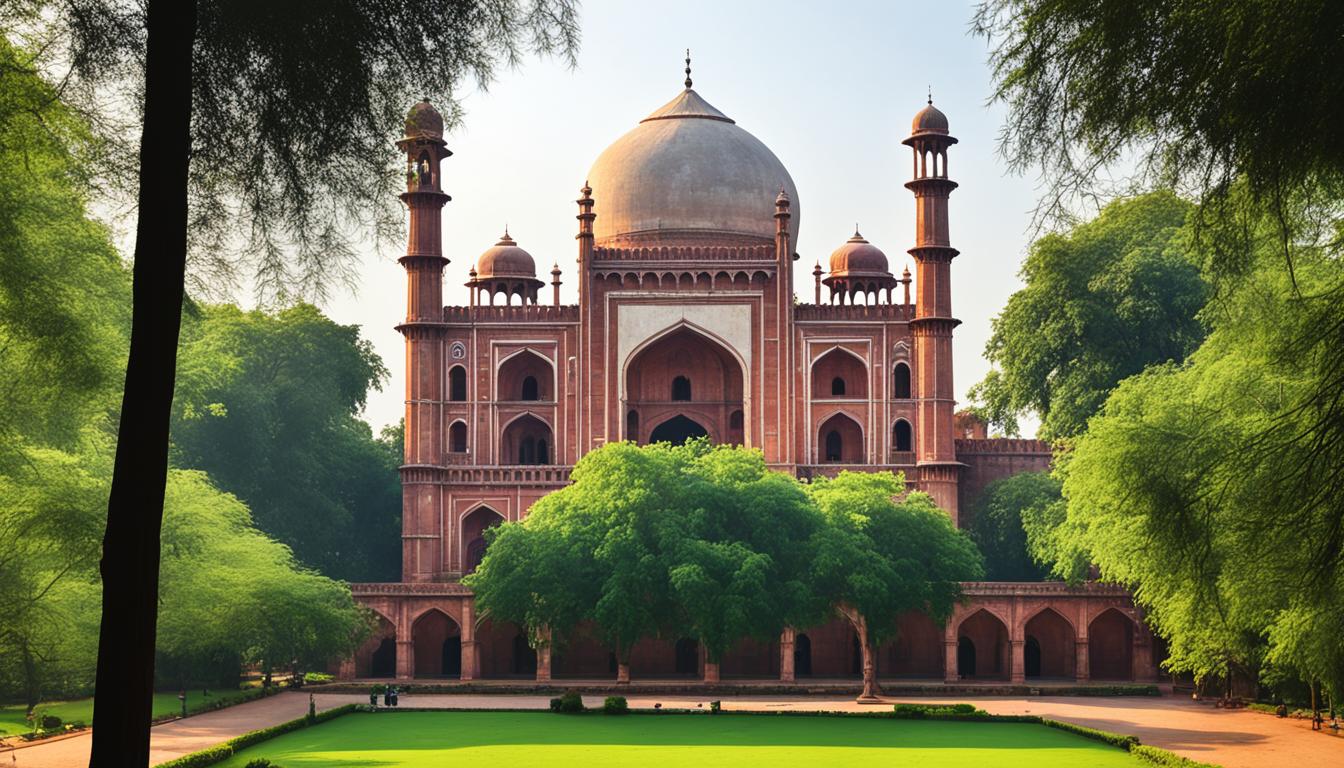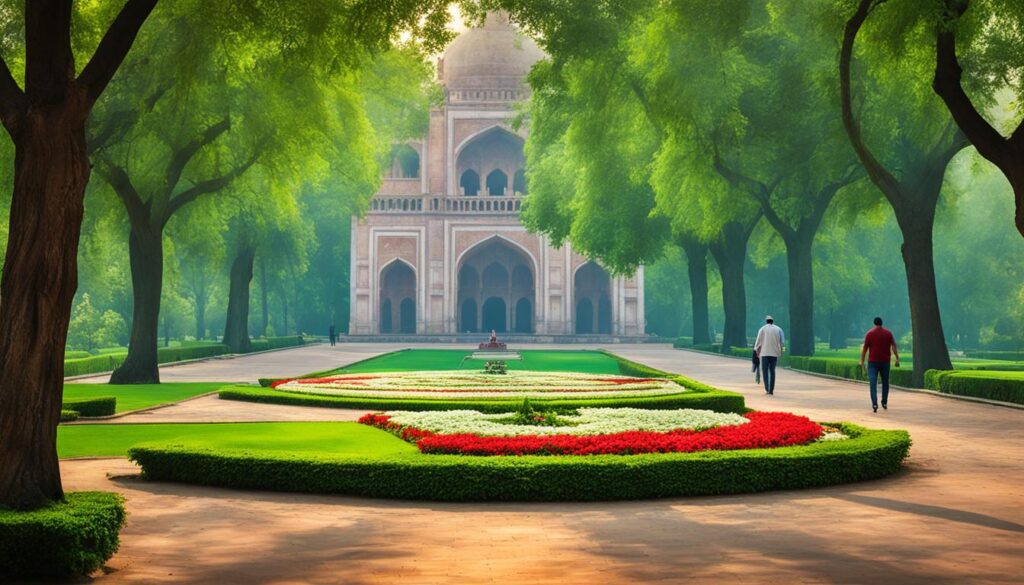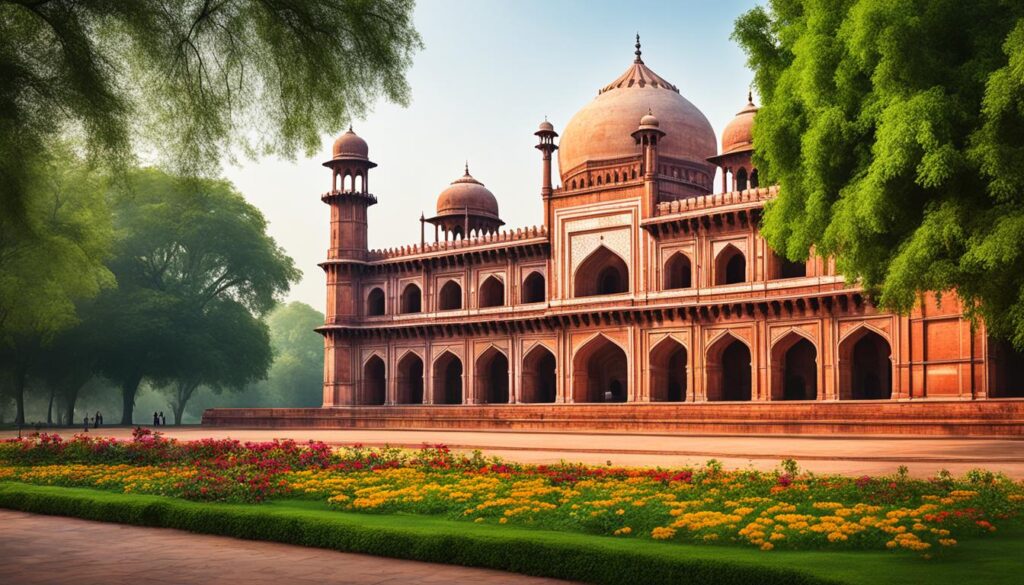
Explore the Majesty of Safdarjung Tomb – Visit Now
In India, it’s said that every stone has a tale to tell. In Delhi’s buzzing city life, Safdarjung Tomb offers a glimpse of Mughal elegance. As sunlight warms the sandstone and marble, you’re taken back to the 18th century. This era was marked by architectural legends whose works continue to inspire.
Walking into the tomb feels like entering a different time. The air around you changes as you explore Safdarjung Tomb; it’s an experience many travelers seek. History comes to life through its detailed carvings and silent domes. Here, at Safdarjung Tomb, you witness the height of Mughal splendor and charm.
Looking at the verdant gardens around the tomb, time in Delhi’s heart seems to stand still. This jewel of history captivates all who visit, inviting you to a world once ruled by monarchs. Ready to explore Safdarjung Tomb? Delhi’s regal history awaits to unfold before you.
Unveiling the Grand History of Safdarjung Tomb
The Safdarjung Tomb is filled with stories from the past. It showcases the Mughal dynasty’s impact on India’s history and architecture. This beautiful site is more than a tomb. It tells about power, creativity, and Mughal architecture that has lasted for ages.
The Rise of Safdarjung: From Persian Native to Mughal Statesman
Safdarjung’s rise from Persia highlights the Mughal dynasty’s welcoming nature. His journey from Persia to a respected Mughal statesman is key in the tomb’s history. His intelligence and ambition saw him become Prime Minister, making his mark in Mughal history.
Final Resting Place of a Mughal Powerhouse: The Inception of Safdarjung Tomb
As the Mughal era ended, the tomb became a sign of fading imperial power. It serves as the final resting place for Safdarjung. The site’s beginning shows the decline of the empire, highlighting the importance of Safdarjung. The Safdarjung Tomb history is closely linked to this powerful man’s life story.
Reflecting Mughal Imperial Prowess: The Architectural Heritage of the Tomb
The Safdarjung Tomb architecture reflects Mughal grandeur in design and engineering. It showcases the peak of Mughal architecture, blending richness with solemn beauty. This site represents the height of Mughal architectural achievement.
Safdarjung’s Tomb is more than a burial place. It symbolizes history, power, and artistic effort. Visiting the tomb offers a deep look into an influential empire and its enduring architectural gifts.
The Architectural Marvel of the Safdarjung Tomb
The Safdarjung Tomb is a prime example of 18th-century Mughal art. It showcases India’s rich history and architectural genius. This magnificent structure holds a deep sense of history. It’s a symbol of a rich heritage that draws architects, historians, and tourists.
Capturing Mughal Artistry: A Walkthrough of Tomb’s Design
The Safdarjung Tomb’s design tells a story of grandeur and detail. It has ornate chambers, decorative motifs, and lush greenery, showcasing the Mughal’s luxurious life. Walking through the complex reveals the blend of shadow and light. This highlights the detailed work and craftsmanship in the stone.
The Significance of the “Eight Paradises” Design
The “Eight Paradises” design of the Safdarjung Tomb mixes Persian and Islamic elements. Its octagonal layout has a main chamber and eight smaller ones, representing paradise levels. This design’s beauty lies in its spiritual meaning and geometric precision.
Preservation of History: Safdarjung Tomb’s Guardianship by ASI
The Archaeological Survey of India (ASI) works hard to preserve this Mughal heritage site. ASI’s dedication ensures the tomb’s beauty and structure are kept for future generations. Their work connects past stories with today’s curious minds.
Let’s look at the tomb’s architecture and ASI’s preservation efforts:
| Architectural Feature | Description | ASI Preservation Measures |
|---|---|---|
| Main Mausoleum | Central burial chamber crowned by a grandiose dome | Structural reinforcement and restoration of the dome |
| Decorative Inscriptions | Calligraphic inscriptions featuring Quranic verses | Cleaning and careful restoration of intricate carvings |
| Garden Layout | Charbagh garden plan representing paradise on earth | Landscaping and maintenance of garden paths and flora |
| Water Channels | Reflective water channels enhancing the serenity of the complex | Revival of water systems and remediation of water flow |
| Jali Work | Intricate latticed screens allowing for the play of light and air | Repair and conservation of historic jali patterns |
In summary, the Safdarjung Tomb is more than a burial site; it’s a masterpiece of Mughal art. It reflects the peak of Mughal craftsmanship. Thanks to the ASI’s preservation work, its spirit and legacy continue to live on. It stands as a respected piece of history amidst modern times.
Relishing the Gardens of Safdarjung Tomb
The Safdarjung Tomb gardens are a peaceful spot near a historic site. As you enter, the busy city feels far away. The Safdarjung Tomb gardens are beautifully arranged, reminding us of past splendor. Here, green lawns, trees, and decorative plants show the beauty of old Mughal gardens.

Walking here, you feel connected to history. Birds sing and leaves rustle, making the place feel calm and peaceful. The layout of the Safdarjung Tomb gardens is balanced, showing the harmony of nature. This design is a classic part of Mughal gardens.
- Embracing Nature’s Harmony
- Intertwined with History
- Sanctuary Amidst the City
“Here, amidst the lush expanse of the Safdarjung Tomb gardens, history whispers its timeless tales, inviting visitors to pause, reflect, and rejuvenate.”
The gardens attract many kinds of visitors. Kids play, friends talk softly, and some people sit quietly, thinking. The Safdarjung Tomb gardens are more than just pretty scenery. They are a beloved spot for everyone, bringing the community together.
| Feature | Description | Significance |
|---|---|---|
| Central Fountain | An elegant marble fountain | Symbol of life and rejuvenation |
| Tree Avenues | Symmetrical plantings of native trees | Offers shade and a sense of continuity |
| Floral Displays | Seasonal flowers in vibrant colors | Highlights the changing seasons and natural beauty |
As the day ends, the Safdarjung Tomb gardens glow under the sunset. This scene melds the garden’s natural beauty with its rich history. Experiencing the gardens at Safdarjung Tomb is truly special. It blends history, art, and nature in a memorable way.
Discover the Safdarjung Tomb Location and Accessibility
Planning a trip to Safdarjung Tomb takes you back to the Mughal era. Located in the heart of New Delhi, it’s easy to get to. Knowing the Safdarjung Tomb location, when it’s open, and how much it costs is key to a good visit.

Safdarjung Tomb Timings: Planning Your Visit
The Safdarjung Tomb timings suit morning and afternoon visitors. It opens at sunrise and closes at sunset. This gives you plenty of time to see the beautiful monument to Safdarjung. Be sure to check local visiting hours, especially on holidays or during special events.
Conveniently Located: Safdarjung Tomb Nearest Metro Station and Entrance Fee
Getting to Safdarjung Tomb is easy thanks to the nearby Jor Bagh metro station on the Yellow Line. It’s a quick trip from many parts of the city. The Safdarjung Tomb entrance fee is affordable, inviting everyone to explore the Mughal legacy.
- Nearest Metro Station: Jor Bagh (Yellow Line)
- Entrance Fee: Nominal (Free entry for children up to 15 years)
Knowing about the location, timing, and cost helps make your visit smooth. Get ready to be amazed by the history and beauty of the Safdarjung Tomb.
Exploring the Majesty of Mughal Dynasty
The Mughal dynasty’s grandeur echoes through time, especially at the Safdarjung Tomb in Delhi. This tomb is the last monumental tomb garden of the Mughals. It shows the power, artistry, and soulful engineering of their era. Understanding the visiting hours is key for a peaceful visit.
A Sanctuary Preserved: Safdarjung Tomb Visiting Hours
The past meets the present at Safdarjung Tomb. The Mughal dynasty’s details fascinate many, while easy access is important for today’s visitors. Knowing the visiting hours helps plan a visit that’s worth remembering.
| Day of the Week | Visiting Hours | Last Entry Time |
|---|---|---|
| Monday | 7:00 AM – 5:00 PM | 4:30 PM |
| Tuesday | 7:00 AM – 5:00 PM | 4:30 PM |
| Wednesday | 7:00 AM – 5:00 PM | 4:30 PM |
| Thursday | 7:00 AM – 5:00 PM | 4:30 PM |
| Friday | 7:00 AM – 5:00 PM | 4:30 PM |
| Saturday | 7:00 AM – 5:00 PM | 4:30 PM |
| Sunday | 7:00 AM – 5:00 PM | 4:30 PM |
Planning your visit to the Safdarjung Tomb is easier with these hours. They allow you to enjoy history at your own pace. With this info, you’re ready to explore and appreciate the Mughal empire’s lasting impact.
Conclusion
Going to The Safdarjung Tomb means exploring Mughal grace. This place isn’t just an old structure; it tells a story. It shows India’s culture in a beautiful way. Everything about the tomb is covered here, from its creation to being a heritage site now. It’s where history comes alive among beautiful Mughal architecture and gardens.
Think about the beautiful Mughal history waiting for you. The past of the Safdarjung Tomb wraps you in old tales. The quiet gardens are a peaceful break from busy city life. This gem in Delhi shows the artistic skill of its era. Visiting the tomb changes you. It makes you admire the Mughal legacy in India’s history.
This story hopefully made you want to see the Safdarjung Tomb. It’s important for those who love history and architecture. The tomb stands as a proud piece of India’s history and architectural wins. So, make plans to visit. Get ready to be amazed by the Safdarjung Tomb. It captures the Mughal era’s essence beautifully.
FAQ
What is the history behind Safdarjung Tomb?
Safdarjung Tomb has a fascinating history. It starts with Safdarjung, who was from Persia. He became a powerful Mughal statesman. His journey took him from Oudh to becoming the Prime Minister of India.
What is the significance of Safdarjung Tomb?
Safdarjung Tomb marks the resting place of a key Mughal figure. It shows the Mughal’s architectural skills. And it highlights their power.
What can you say about Safdarjung Tomb’s architecture?
Safdarjung Tomb stands out for its history and beauty. Its intricate designs showcase Mughal craft. The design, with “eight paradises” around the main chamber, is unique and beautiful.
What are the attractions of the Safdarjung Tomb gardens?
The gardens around Safdarjung Tomb are peaceful and beautiful. They have lush greenery, a symmetrical design, and lovely paths. It’s a great spot to unwind.
Where is Safdarjung Tomb located and how can I reach it?
You’ll find Safdarjung Tomb in Delhi’s Lutyens zone. The closest metro is Jor Bagh. It’s easy to get to by various transport methods. We’ll give you info about its hours and entry costs too.
What are the visiting hours for Safdarjung Tomb?
Safdarjung Tomb has set hours for visitors. We will share the visiting times to plan your visit.
What can I expect when visiting Safdarjung Tomb?
Visiting Safdarjung Tomb lets you see the Mughal dynasty’s splendor. You’ll learn about its history and architectural greatness. It’s a glimpse into the era of the Mughals.
Source Links
- https://gowithharry.com/safdarjung-tomb-history-timing-ticket/
- https://traveltriangle.com/blog/places-to-visit-near-humayun-tomb/
- https://www.vacationtripindia.com/10-must-visit-attraction-on-your-golden-triangle-tour/

Leave a Reply